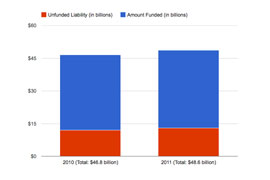Cronkite News has moved to a new home at cronkitenews.azpbs.org. Use this site to search archives from 2011 to May 2015. You can search the new site for current stories.
Report: Arizona’s unfunded public pension liability carries risks
PHOENIX – Arizona risks higher taxes and spending cuts to essential government programs if it doesn’t address a gap in funding for pensions owed to public employees, according to a report by the Pew Center on the States and the Laura and John Arnold Foundation.
“It is in a stage where something must be done or it might be very, very difficult in the future to fix these systems without having employees and taxpayers go through more pain than is necessary right now,” said Josh McGee, vice president for the Public Accountability Initiative at the Laura and John Arnold Foundation.
The report, released in late November, said that in 2011 Arizona was short by $13 billion on the assets needed to cover the state’s $48 billion in total pension obligations. That’s up from a $12 billion shortfall in 2010.
Ideally, McGee said, the state should have enough assets on hand to meet long-term pension obligations for state and local government employees. He said paying down the unfunded liability is a challenge that requires policymakers to make thoughtful and fiscally responsible decisions.
“They need to make sure the plan is sustainable and doesn’t put the state at risk of future funding challenges,” he said.
The state’s pension system offers traditional defined benefit plans, meaning employers promise future employee retiree benefits based on a participant’s length of service and ending salary. So when investment returns are poor, policymakers are still stuck with promised payments and need to find ways to make up for the shortfall.
McGee said the state should consider adopting a more predictable plan under which employers commit to contributing a fixed percentage of salary to an employee account for every year worked.
“It’s just really hard to predict what costs will be in the future and these systems are countercyclical in that pension costs rise whenever the economy is slumping,” McGee said. “Politicians that deal with costs that rise also see very tight budgets.”
McGee said the state also needs to re-examine its payment schedule and determine if it would pay down the unfunded liability over a reasonable timeframe. For example, the Arizona State Retirement System, the state’s largest trust, has a 30-year rolling amortization system. That means the trust has a 30-year period to pay down the unfunded liability, but the period gets reset each year and makes it harder to achieve a fully funded status, he said.
Paul Matson, director of the Arizona State Retirement System, said he plans to propose to the Legislature a shorter, fixed timeframe to get to a fully funded status. While public employees contribute portions of their pay to fund their retirement benefits, his proposed schedule would be long enough to allow all generations of employees to equally help pay the unfunded liabilities.
“You would want to pay it down over something like a 20-year period to make sure the contribution rates don’t get too high and put all the burden on one generation,” Matson said. “You want to smooth it out between the generations that will participate in getting a pension.”
Arizona’s public pension system – which also includes the Public Safety Personnel Retirement System, Corrections Officer and Elected Officials’ Retirement Plan – is 73 percent funded. Eighty percent funded is generally regarded as healthy. Pensions for elected officials and public safety workers have the lowest funding levels at 63 percent.
Jim Hacking, administrator of the Public Safety Personnel Retirement System, said he blames the decade’s stock market declines and low rates of return on investment for the growing funding gap.
“What would be best of course is a higher level of economic growth which in turn would benefit the financial markets and result in higher rates of return on the investor assets of the systems,” he said.
A 2011 state law has a bipartisan 13-member committee headed by Arizona State Treasurer Doug Ducey addressing the funding gap. The Defined Contribution and Retirement Study Committee, which has met several times this year, will present reform options to the governor and the Legislature.
“Having an affordable, secure and sustainable pension system should be the result of true pension reform, but there are some difficult choices ahead that will require good information and very thoughtful analysis,” Ducey said.
He said how to close the funding gap will ultimately be left to the Legislature, but it will require immediate action in order to ensure that the state will have enough money available for retirees today and in the future.
“It’s important to remember that we’re talking about the people who police the streets, put out fires, manage the public records and fix the roads,” Ducey said. “It’s critical that they can depend on the retirement savings and that these retirements will be there for them when they retire.”







